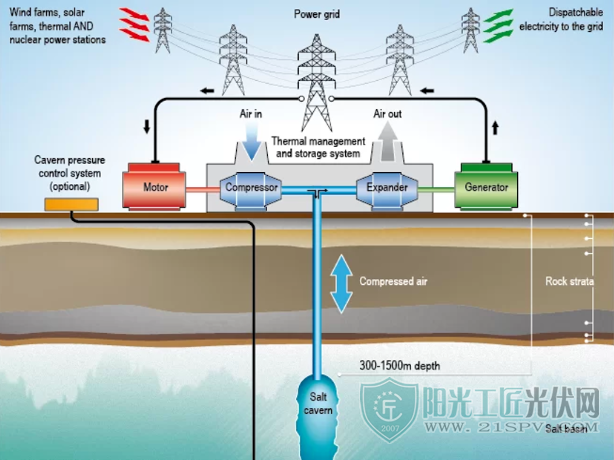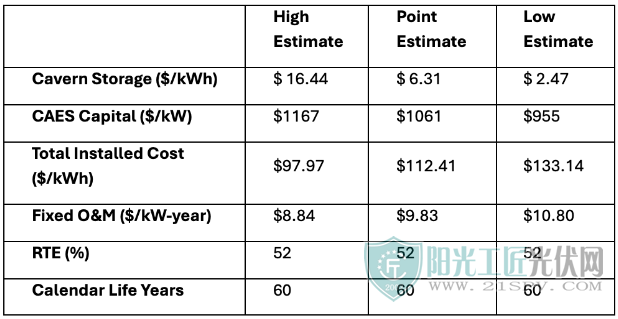全球范围内可再生能源发电的增长正在经历显着的增长。根据美国能源信息署(EIA)的预测,预计到 2050 年,风能和太阳能在美国发电结构中的份额将达到 38%,是 2019 年记录比例的两倍。可再生能源系统中的储能(CAES)具有多种经济、技术和环境优势。
What is Compressed Air Energy Storage?
什么是压缩空气储能?
By 2030, it is anticipated that renewable energy sources will account for 36 percent of global energy production. Energy storage systems will be instrumental in attaining this objective. Mechanical storage systems stand out among the available energy storage methods due to their reduced investment expenses, prolonged lifetimes, and increased power/energy ratings. Notably, commercialized large-scale Compressed Air Energy Storage (CAES) facilities have arisen as a prominent energy storage solution.
到 2030 年,预计可再生能源将占全球能源生产的 36%。储能系统将有助于实现这一目标。机械存储系统因其投资费用减少、使用寿命延长以及功率/能量额定值提高而在可用的能量存储方法中脱颖而出。值得注意的是,商业化的大型压缩空气储能(CAES)设施已成为一种重要的储能解决方案。
Since the late 1970s, (CAES) technology has been commercially available. This energy storage system functions by utilizing electricity to compress air during off-peak hours, which is then stored in underground caverns. When energy demand is elevated during the peak hours, the stored compressed air is released, expanding and passing through a turbine to generate electricity.
自 20 世纪 70 年代末以来,(CAES) 技术已投入商业应用。该储能系统的工作原理是在非高峰时段利用电力压缩空气,然后将空气储存在地下洞穴中。当高峰时段能源需求增加时,储存的压缩空气会被释放,膨胀并通过涡轮机发电。

Traditional Compressed Air Energy Storage System Configurations
传统压缩空气储能系统配置
CAES technology encompasses different types, including adiabatic systems and diabatic systems. The key distinction between these configurations lies in how they handle the heat generated during the compression process.
CAES 技术涵盖不同类型,包括绝热系统和非绝热系统。这些配置之间的主要区别在于它们如何处理压缩过程中产生的热量。
The diabatic CAES systems are the first-generation technology. In these systems, ambient air is compressed using a compressor train. The compression process generates waste heat, which is then dissipated to the surrounding environment through intercoolers. During the discharge phase, fuel is combusted to heat the air before its expansion in the turbines. This combustion process allows for the generation of electricity during peak demand periods. The adiabatic configuration of CAES has been under development since the late 1970s, aiming to address the limitations of diabatic CAES. This particular compressed air energy storage system focuses on effectively capturing and storing the waste heat generated during compression. The stored heat is then recycled to elevate the turbine inlet temperature of the compressed air during the discharge phase. As a result, the adiabatic CAES system aims to reduce or even eliminate the reliance on fossil fuels, offering a more sustainable energy storage solution.
非绝热 CAES 系统是第一代技术。在这些系统中,使用压缩机组压缩环境空气。压缩过程产生废热,然后通过中间冷却器消散到周围环境。在排放阶段,燃料燃烧以在空气在涡轮机中膨胀之前加热空气。这种燃烧过程可以在高峰需求期间发电。 CAES 的绝热结构自 20 世纪 70 年代末以来一直在开发中,旨在解决非绝热 CAES 的局限性。这种特殊的压缩空气能量存储系统专注于有效捕获和存储压缩过程中产生的废热。然后,储存的热量被回收,以在排放阶段提高压缩空气的涡轮入口温度。因此,绝热 CAES 系统旨在减少甚至消除对化石燃料的依赖,提供更可持续的能源存储解决方案。
Recent Developments in Novel Configurations of CAES
CAES 新颖配置的最新进展
In addition to the adiabatic and diabatic configurations, two other types of CAES systems have been proposed: isothermal CAES (I-CAES) and supercritical CAES. The primary objective of I-CAES is to maintain stable compression and expansion temperatures of the compressed air during the charging and discharging processes, respectively. This is achieved by implementing a quasi-isothermal process.
除了绝热和非绝热配置之外,还提出了另外两种类型的 CAES 系统:等温 CAES (I-CAES) 和超临界 CAES。 I-CAES 的主要目标是在充电和放电过程中分别保持压缩空气稳定的压缩和膨胀温度。这是通过实施准等温过程来实现的。
On the other hand, supercritical CAES involves compressing the air to a supercritical thermodynamic state, where the waste heat generated during compression is recovered and stored in a thermal energy storage system. The compressed air is then liquefied and stored in a dedicated cryogenic tank. During the discharge phase, the liquid air is re-gasified, heated using the stored thermal energy, and subsequently expanded through a turbine train to generate electricity, which can be supplied back to the grid. This process has an efficiency of around 68%.
另一方面,超临界CAES涉及将空气压缩至超临界热力学状态,其中压缩过程中产生的废热被回收并存储在热能存储系统中。然后压缩空气被液化并储存在专用的低温罐中。在放电阶段,液态空气被重新气化,利用储存的热能进行加热,随后通过涡轮机组膨胀以产生电力,并可回馈电网。该过程的效率约为 68%。
Components and Operational Necessities
组件和操作必需品
The primary components of a conventional CAES plant cycle include a motor/generator with pulleys on both ends (to engage/disengage it to/from the compressor train, expander train, or both).
Multistage air compressors with intercoolers, which reduce the required power during the compression cycle, and an aftercooler, which reduces the required storage volume play a vital role in energy storage.
The next component is the control system for an expander train composed of high- and low-pressure turbo-expanders with burners between stages.
Accessories (fuel storage and management, refrigeration systems, mechanical systems, power systems, and heat exchangers).
Storage of pressurized air underground or aboveground, including piping and fixings.
传统 CAES 设备循环的主要组件包括两端带有滑轮的电动机/发电机(用于将其与压缩机组、膨胀机组或两者接合/分离)。
带有中间冷却器的多级空气压缩机可减少压缩循环期间所需的功率,而后冷却器可减少所需的存储体积,在能量存储中发挥着至关重要的作用。
下一个组件是膨胀机组的控制系统,该膨胀机组由高压和低压透平膨胀机组成,各级之间带有燃烧器。
配件(燃料储存和管理、制冷系统、机械系统、动力系统、热交换器)。
地下或地上压缩空气的储存,包括管道和固定装置。
Advantages
优点
CAES is utilized to improve high-demand preservation, thus decreasing the electrical grid's burden. This enables energy providers to supply adequate power for the entire service area without producing additional energy during peak demand. CAES, when implemented on a lesser scale, can reduce reliance on the electrical infrastructure, thus decreasing energy costs and maintenance costs.
CAES 用于改善高要求的保护,从而减轻电网的负担。这使得能源供应商能够为整个服务区域提供充足的电力,而无需在高峰需求期间产生额外的能源。当小规模实施时,CAES 可以减少对电力基础设施的依赖,从而降低能源成本和维护成本。
It can store energy for several hours to days, assuring a consistent power supply during periods of high demand or when intermittent resources are not producing. The use of CAES as a supplementary energy source contributes to the enhancement of power grid stability during periods of excessive electrical demand. In addition, these systems require relatively little upkeep compared to other methods.
它可以储存能量数小时至数天,确保在高需求期间或间歇性资源不生产时保持稳定的电力供应。使用CAES作为补充能源有助于在电力需求过剩期间增强电网稳定性。此外,与其他方法相比,这些系统需要的维护相对较少。
Limitations and Challenges
限制和挑战
Despite such advantageous features, compressed air energy storage falls short owing to certain challenges and limitations. The scarcity of appropriate geological formations for underground caverns may hinder the extensive application of CAES. A viable geographical location is required for the integration of CAES with the energy production source. Additionally, compressing the air followed by the expansion processes in CAES systems leads to losses of energy due to thermal dispersion, thereby reducing overall efficiency.
尽管有这些有利的特征,但压缩空气能量存储由于某些挑战和限制而存在不足。地下洞穴缺乏合适的地质构造可能会阻碍 CAES 的广泛应用。 CAES 与能源生产源的整合需要一个可行的地理位置。此外,CAES 系统中压缩空气后进行膨胀过程会因热分散而导致能量损失,从而降低整体效率。
Even in the presence of such challenges, all over the world, CAES projects are underway. The Chinese Academy of Sciences' Institute of Engineering Thermo-physics recently activated a 100 MW compressed air energy storage facility in Zhangjiakou, Hebei province. The facility is comprised of a multistage, high-load compressor, an expander, and a supercritical heat storage and heat exchanger with outstanding efficiency.
即使面临此类挑战,世界各地的 CAES 项目仍在进行中。中国科学院工程热物理研究所近日在河北张家口启动了100兆瓦压缩空气储能设施。该设施由多级高负载压缩机、膨胀机以及效率出色的超临界蓄热和热交换器组成。
Market Assessment
市场评估
CAES appears to be a natural fit with the wind farms presently under construction. This is because CAES can operate on a brief enough time scale to balance out variations in the power grid that are triggered by wind fluctuations. The future market potential for compressed air energy storage (CAES) systems is substantial. Experts have published a report in Allied Market Research stating that the global compressed air energy storage market was worth $4 billion in 2021 and is expected to reach $31.8 billion by 2031, expanding at a compound annual growth rate (CAGR) of 23.6% from 2022 to 2031. This is primarily because renewable energies are anticipated to gain market influence in the foreseeable future.
CAES 似乎非常适合目前正在建设的风电场。这是因为 CAES 可以在足够短的时间范围内运行,以平衡风力波动引发的电网变化。压缩空气储能(CAES)系统未来的市场潜力巨大。专家在联合市场研究公司发表报告称,2021年全球压缩空气储能市场价值40亿美元,预计到2031年将达到318亿美元,从2022年到2022年将以23.6%的复合年增长率(CAGR)扩张。 2031年。这主要是因为可再生能源预计将在可预见的未来获得市场影响力。
Cost and Performance Assessment of CAES
CAES 的成本和性能评估
It is anticipated that CAES will dominate the energy storage market. According to calculations done by Pacific Northwest National Laboratory, a 1000MW CAES plant incurs the following costs:
预计CAES将主导储能市场。根据太平洋西北国家实验室的计算,一座1000MW CAES电站的成本如下:

原标题:压缩空气储能,如何工作?

 扫描关注微信
扫描关注微信








 宁德时代吴凯...
宁德时代吴凯... 天合光能陈奕...
天合光能陈奕... 刘岩: 追光行...
刘岩: 追光行... 黄震院士:大...
黄震院士:大...